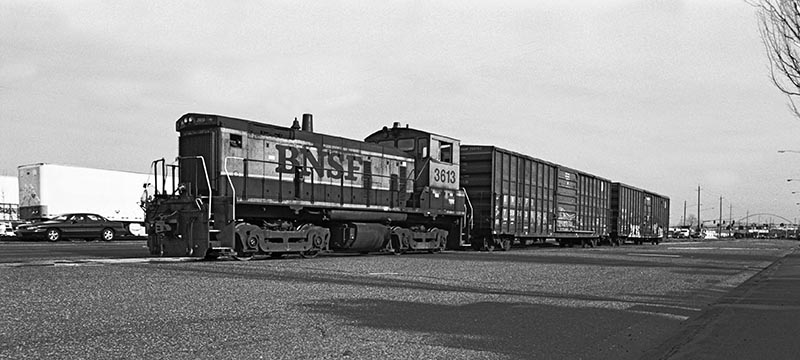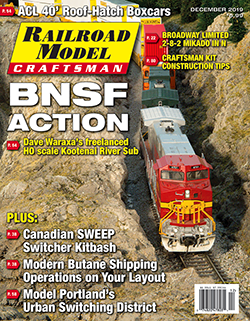 By Alexander Benjamin Craghead/photos as noted
By Alexander Benjamin Craghead/photos as noted
In today’s world of unit trains and six-axle power, the end-cab switcher is a dying breed. From the Alco S-1 of 1940 to the Electro-Motive Division MP15 of the 1980s, these small diesel-electric locomotives, now all but gone from the roster of Class 1 railroads, were once a ubiquitous part of North American railroading.
While they were mainstays of railway yards across the country, it was the industrial switching district where the end-cab switcher, with its short wheelbase and light weight, was most at home. They had no trouble at all in the tight confines of the old, steam-era urban industrial lines, jammed up between parked cars and packed-in buildings.
Very few switchers still hold down roles like these, but in Portland, Oregon, one example survives: the Guild’s Lake industrial park. Developed by the Port of Portland and the Spokane, Portland & Seattle Railway in a filled lakebed alongside the Northern Pacific main line, Guild’s Lake is a product of the 1950s, a vast, 1,600-acre preserve of machining, manufacturing, and distribution. On the edge of the old northwest factory and warehouse districts, Guild’s Lake was meant to be the latest in modern industry, designed from the ground up with wide roads and sprawling buildings able to accommodate both railcars and truck traffic.
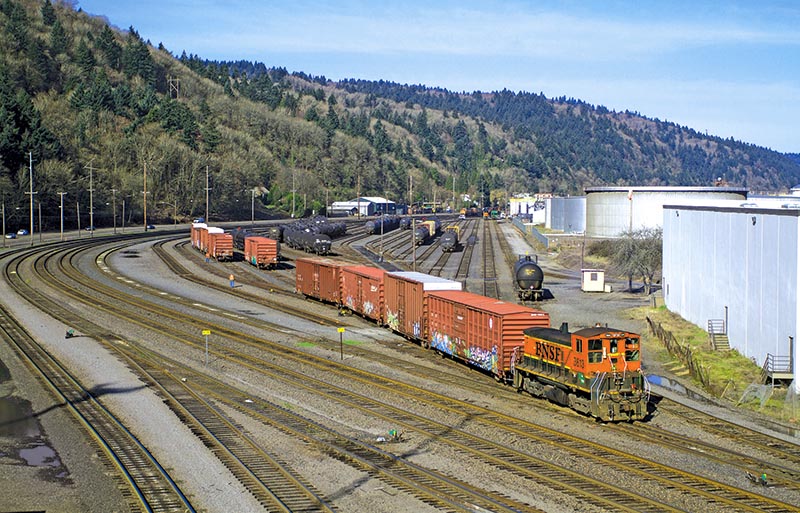
Job 101 sorts its unusually large number of cars in the BNSF Willbridge Yard before proceeding to the 12th Street District. By organizing their cars in the spacious yard next to the mainline, they can reduce their work in the downsized 12th Street industrial yard. —Kyle Weismann-Yee photo
Although there are few active customers remaining, the industrial park’s vast network of track remains largely intact. Up through the 1970s, there were dozens of active spurs and shippers, and enough business to keep a switcher busy all day. Guild’s Lake is an ideal prototype for modeling the practices of industry switching, or what is sometimes called “loose-car” railroading.
A Summer Day in Guild’s Lake: 1975
It’s 1975. Gerald Ford is president, the Eagles’ “One of These Nights” is in constant rotation on the radio, and Guild’s Lake industrial park is hopping. You’re the conductor on Burlington Northern Job 101, the Guild’s Lake switcher, and your day begins at 8:00 a.m. at Willbridge Yard.
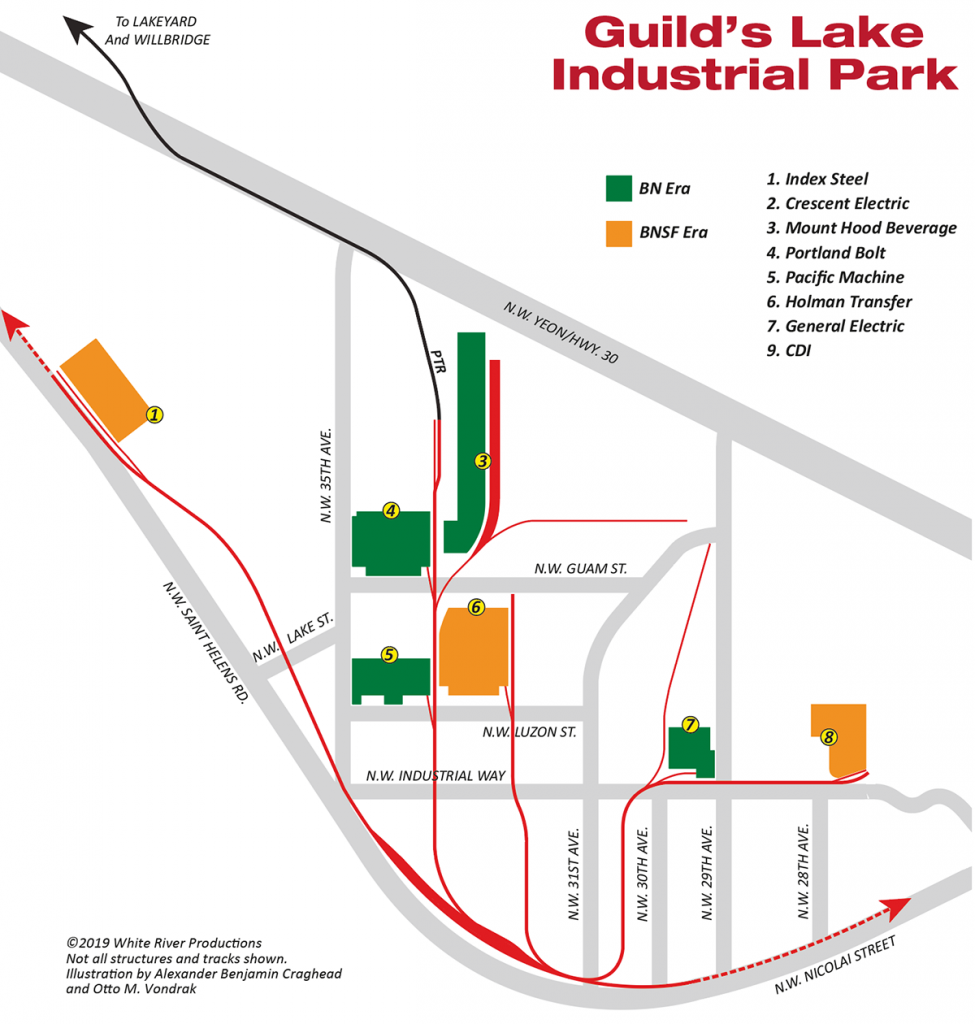
You get your switch list from the yard office, then go walk your train. It’s a long list: three refeers for Terminal Transfer, two boxcars for Holman, a boxcar of tires for Goodyear, two cars of paper for J.K. Gill, and a covered gondola containing coiled steel for Columbia Warehouse. Fresh on the job, you consult your track diagram book (known as “SPINS” on BN). You see that Guild’s Lake has so many spurs that it consists of three separate zones: Zone 2, the former interurban main line along St. Helens Road; Zone 3, the Industrial Avenue lead, and Zone 4, the Timber Lead.
Back at the locomotive, you help the engineer lift a cooler up to the cab. You guide him to a hook with your cars, lace ’em up, air ‘em up, then head out on the main line towards Lakeyard and Yeon Avenue. Crossing Yeon, you leave the tracks of the Portland Terminal Railroad and enter Guild’s Lake, where you will spend most of your day.
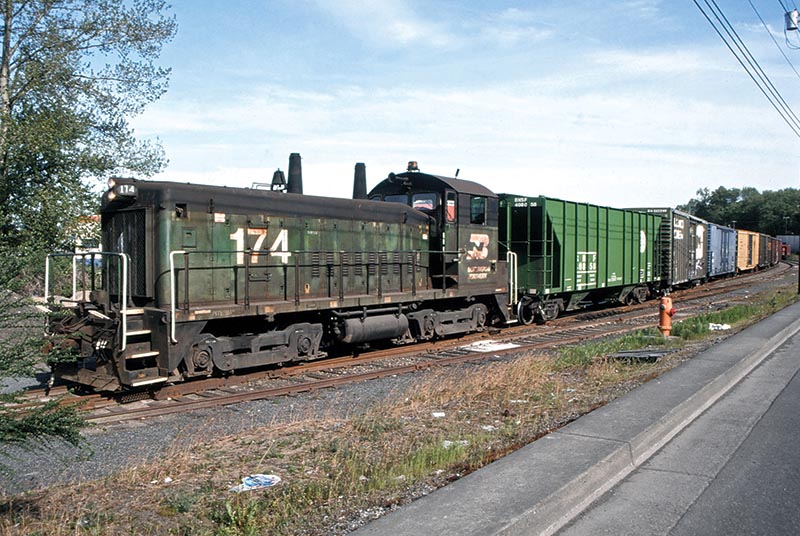
Burlington Northern SW1200 174 (ex-Northern Pacific) was one of many switchers assigned to Guild’s Lake. Nearing the end of her career, no. 174 shoves a cut of cars in April 1998. —Dan Haneckow photo
Terminal Transfer isn’t ready to release its outbound reefers yet, so you skip them and make Holman your first task of the day. Holman is one of the big concrete warehouses that sits along the Timber Lead. You cut the engine and boxcars off from the rest of the cars, then ride the stirrups of the last car down to the switch on the other side of Luzon Street, throw it, then motor up to spot the warehouse. The workers here are sharp, the roll-up door is already open, and 169 can just push the cars in without getting the stack inside the building.
You set the handbrakes, pull the cut lever between the locomotive and the boxcars, and give a hand signal. The 169 pulls back, and you gracefully pull yourself up onto the stepwell and ride it down to the switch. Back onto the cars on the Timber Lead, you get back in the cab and move toward 12th Street Yard. One spot done, about a half dozen more to go…


